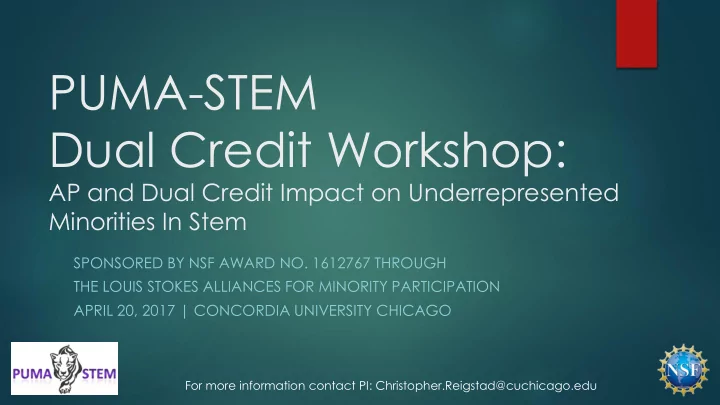

PUMA-STEM Dual Credit Workshop: AP and Dual Credit Impact on Underrepresented Minorities In Stem SPONSORED BY NSF AWARD NO. 1612767 THROUGH THE LOUIS STOKES ALLIANCES FOR MINORITY PARTICIPATION APRIL 20, 2017 | CONCORDIA UNIVERSITY CHICAGO For more information contact PI: Christopher.Reigstad@cuchicago.edu
PUMA-STEM Dual Credit Workshop Goals: 1. Increase awareness of dual credit models and how they benefit URM populations 2. Identify significant barriers to success faced by URMs for each dual credit model. 3. Discuss and develop strategies to overcome these barriers
What is PUMA-STEM? PUMA-STEM stands for Promotion of Underrepresented Minorities in Academic STEM* PUMA-STEM is a collaboration among regional high schools and colleges to increase graduation rates and career success of underrepresented minorities (URMs) in STEM; NSF defines URMs in STEM as including African-American, Hispanic, American Indian, Alaskan Native, and Pacific Islander Funded in September of 2016 by a Pre-Alliance Planning Grant from the NSF (National Science Foundation) and the LSAMP (Louis Stokes Alliances for Minority Participation) The funded grant is sponsoring workshops and research to improve success of URMs in STEM regionally, with broader impact envisioned through expansion of meaningful academic networks and collaborations with STEM business and industry *STEM = Science, Technology, Engineering, and Mathematics
Every Student Succeeds Act (ESSA) …creates an opportunity for states and districts to help more young people enter and complete college by implementing school designs that improve the transition between high school and higher education .
Key Terms in ESSA Dual or concurrent enrollment – A partnership between an institution of higher education and a local educational agency through which a secondary school student has not graduated from high school is able to enroll in one or more post secondary courses and earn credit.
Key Terms in ESSA Early College High School – A partnership between an institution of higher education and a local educational agency that allows participants to simultaneously complete requirements toward earning a regular high school diploma and earn not less than 12 transferable credits to the institution of higher education.
Three Typical Models for Dual Enrollment Programs Community college campus site Virtual campus — taking dual credit online High school campus site Education Commission of the States Access, Finance, Course quality, Transferability of credit
Dual Credit Programs Support College Credit Accumulation and Degree Attainment College-level course experience while having the support in high school Students accumulate college credits early and are more likely to attain a degree. Programs are often discounted or free reducing the overall cost of college
Dual Credit Research Findings More likely to meet college readiness More likely to enter college Lower likelihood of placement into remedial English or math Higher first year grade point average Higher four and six-year college completion rates Shorter time to degree completion
What Works Clearinghouse Summary of Findings Early college high schools aim to provide underserved students with exposure and support in, college while they are still in high school Programs target students traditionally underrepresented in College; first- generation college students, low income families, member of URMs .
Resources How to Scale College in High School, College in High School Alliance, Feb 2017 Dual Enrollment Programs, Institute of Education Sciences — WWC Intervention Report, Feb 2017 At the Crossroads of Access and Opportunity: Funding and Dual Credit in Illinois, Office of Community College Research and Leadership
Small Group Discussion Questions What are the benefits of dual credit and AP programs as they relate to success in college STEM? What are the caveats related to these benefits? What can we do, at the high school and/or college level, to increase participation and success of underrepresented minorities (URMs) in dual credit programs? Institutional policies vary with respect to what forms of high school coursework can be counted as college credit. What are some of the policies at your institution regarding coursework that can counts toward high school and college credit?
Small Group Discussion Questions Do you perceive a difference in the rigor and/or knowledge obtained by students through dual credit courses taught in high school by qualified high school teachers compared to dual enrollment courses where the students attend class at a college (e.g., community college)? (Time permitting) Question for college faculty/staff/students: do you perceive a difference academically in students who participated in dual credit during high school compared to those who did not?
Workshop Agenda/Timeline: 4:30-4:45 Introduction 4:45-5:30 Address discussion questions (groups of approx. 4) 5:30-5:50 Report back to entire group 5:50-6:20 Discuss findings and possible solutions and improvements 6:20-6:30 Wrap-up and next steps
Recommend
More recommend